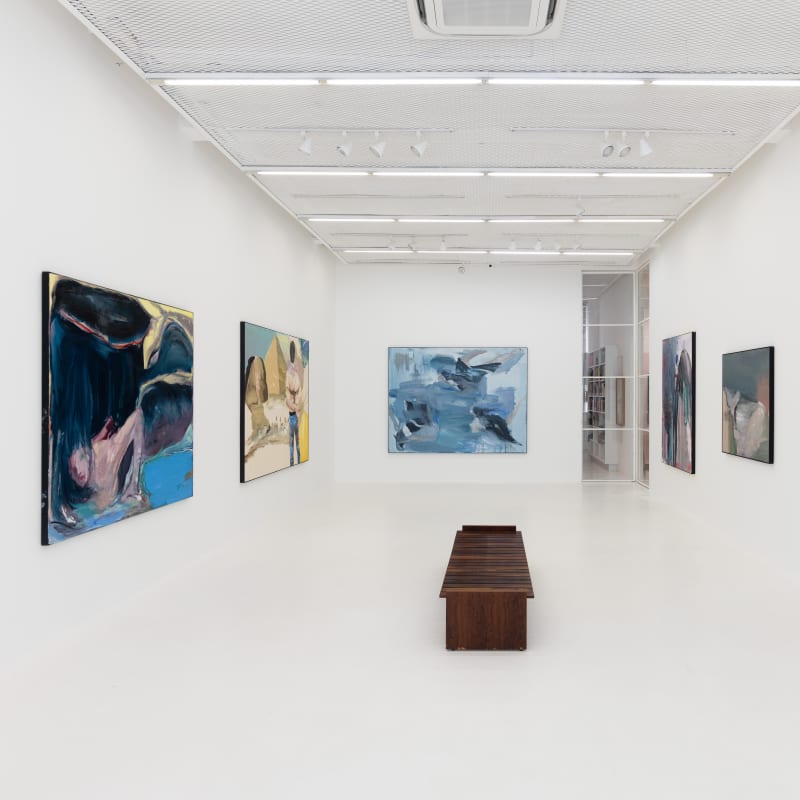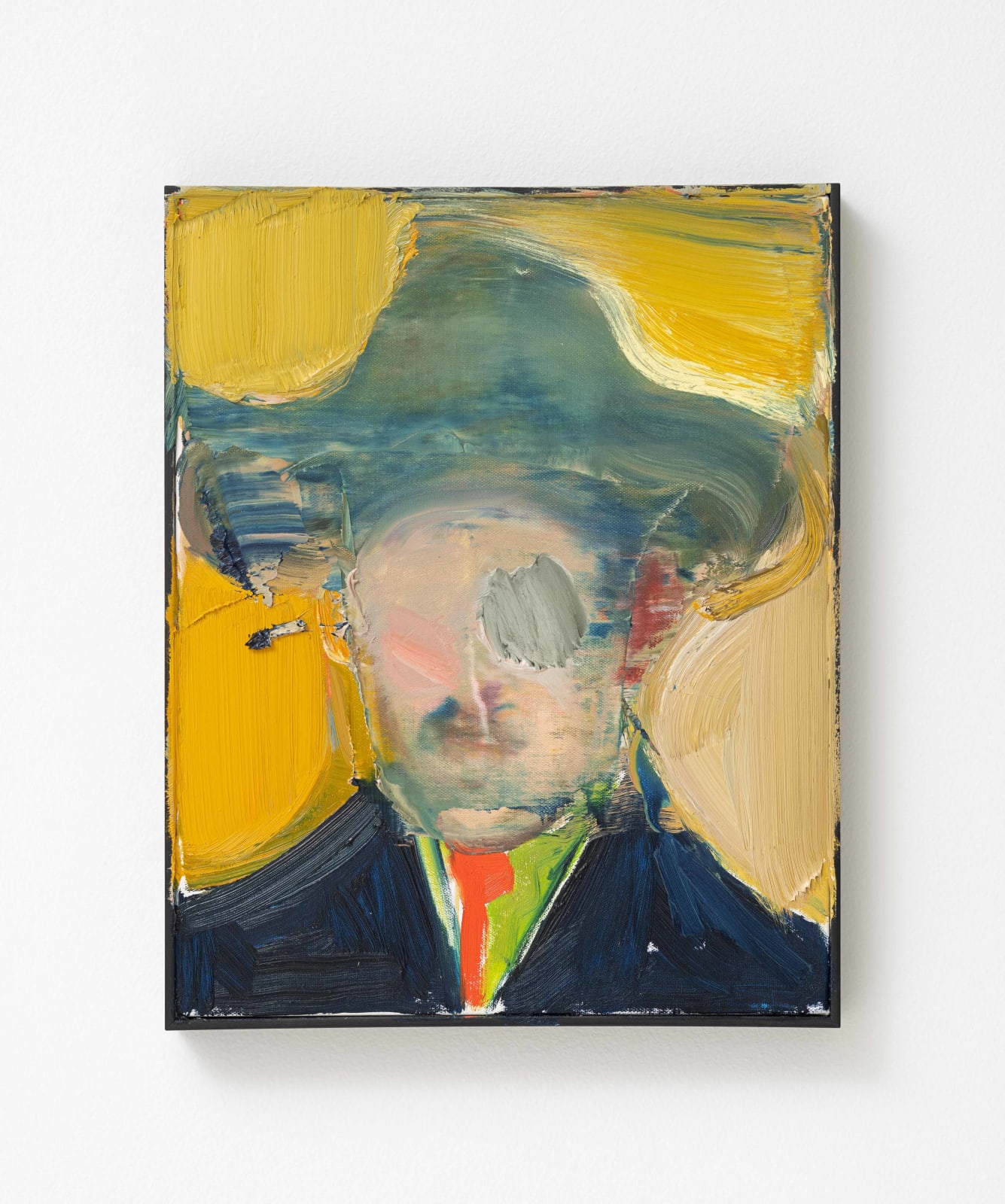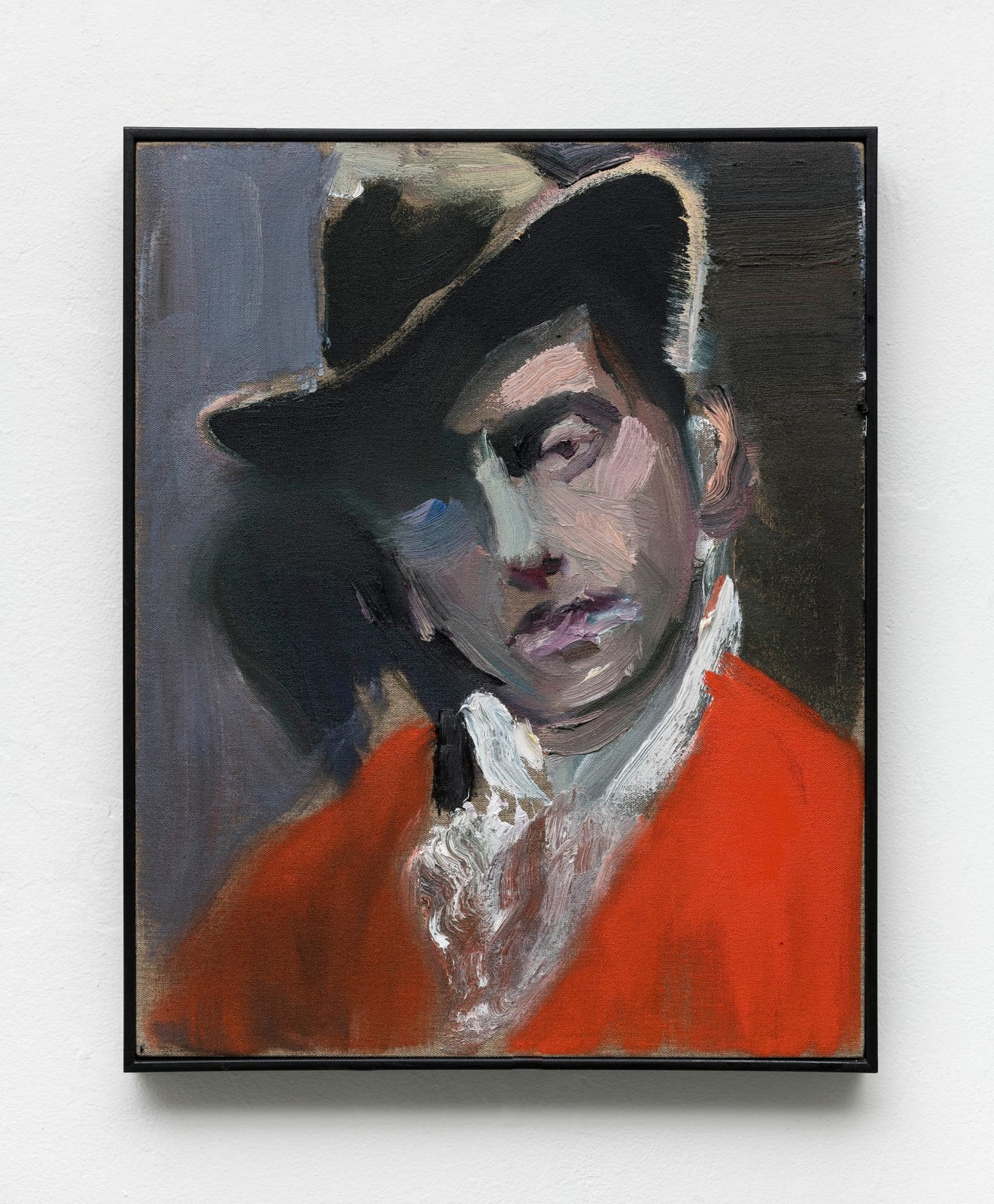Daniel Lannes: paradises: Critical Essay: Tomás Toledo
Artificial paradises, lost paradises
Tomás Toledo
As the visitor enters the show Paradises, by Daniel Lannes, he is confronted by a translucent white curtain, which invites into a nebulous, intimate and dreamlike atmosphere. In this misty vestibule we are questioned by two distinct, but equally magnetic, gazes. The first stems from a small portrait made from a photograph of João do Rio, chronicler of the streets and bohemia of Rio de Janeiro. Painted with the air of a tropical dandy and his face tilted to the left, reinforcing the inquisitive aspect of his gaze, he seems to invite anyone who crosses his path to a lush adventure, which Lannes reiterates when choosing the premonitory title of the painting: Aquele que você vai querer beijar no final da noite [The one you will want to kiss at the end of the night].
The second gaze, vile and seductive, comes from a sailor, painted by Lannes from a photograph printed in a French magazine. Between the photo and the painting, one can perceive a representation, not exactly intentional, of Querelle de Brest, the bisexual, seductive and criminal sailor from the homonymous book by Jean Genet, who was featured in the film Querelle, by Rainer Fassbinder, filmed as an erotic dream (or nightmare) and permeated by an orange and rosy light that also covers Lannes' painting of the sailor.
Traversing the curtain, we come upon two more gazes, both of small portraits of the poet Fernando Pessoa, a key figure in this exhibition which, in its turn, drank from the staggering, numb and decadent universe explored by Álvaro de Campos – one of Pessoa’s heteronyms – in Opiary.
The poem is a first-person narration that takes place on a ship – “Aboard ship in the Suez Canal” – in which the lyrical subject of Álvaro de Campos discusses the missteps of his life permeated by the use of opium, in a dispersive narrative thread, in which the real territorial displacement of the ship’s voyage is merged with a symbolic displacement, mixing chronological time with the escapist and numbing temporality of opium, something enunciated in the first stanza:
“It’s before I take opium that my soul is sick.
To feel life is to wilt like a convalescent,
And so I seek in opium’s consolation
An East to the east of the East.”
It is precisely in this space-time fissure desired in the last verse of the first stanza that the set of paintings in the show seems to settle itself. The paintings evoke scenarios, fantasies, characters and atmospheres from different times, natures and cultures, but which seem strangely familiar with each other and at ease in this delirious-paradise-universe created by Lannes. This ability to inhabit many places in one and the coexistence of different perceptions of reality is closely linked to the type of expanded consciousness provided by opium, something on which Walter Benjamin comments precisely in his text Hashish in Marseilles: “The opium-smoker or hashish-eater experiences the power of the gaze to suck a hundred sites out of one place.”
Continuing the journey through the white cube of the gallery, on the left wall we see three large canvases that refer to the classic genre of painting the human figure in a landscape. The three, as well as the other canvases in the show, bring together pictorial operations typical of Lannes' production: the eloquent use of colors; the shuffling of the figure’s and the background planes; the blurring of the border between abstraction and figuration; the constant use of either saturation and transparency, or a plastered mass of ink with the simple-weave of the canvas on display. Such operations result in paintings that carry the energy of bodily gestures, but at the same time reveal a control and subtlety of the mind.
In the first of them, Meditação [Meditation], we see a scene of classical tenor, a seated man contemplating a muddy lake or an existential abyss. In the second, Opium, a diabolical and lysergic mermaid emerges from an underground ocean or a lost paradise. In the third, he creates a successful pot-pourri of quotations: the scene is an appropriation of the Brazilian royal family's travel album, more specifically of a photograph of Dom Pedro II and his family in Egypt at the foot of the Sphinx. The peculiar group of the royal tour is observed by Lannes’ self-portrait, who appears with his back turned, shirtless, wearing printed pants and with his arms tied by Shibari ropes, creating a landscape painting that is at once historical, autobiographical and fetishist.
On the right wall, the landscape is diluted and the figures gain the first plane, in a sequence of beings that alternate between historical, fictional, mythological and pop universe references. There are four compositions with open interpretations, permeated by suggestiveness and incompleteness. This is reflected in the very making of the paintings, which does not account for faithful representation and narrative totality, and leaves something to be completed by the eye and elaborated by the spectator's imagination.
The first painting in this sequence has, as backdrop, a mixture of shades of green, watery and flowing through the canvas, almost blending with the man seen from the back with his right arm arched and a pronounced phallus. There is something of cave painting in the composition, which is reinforced by its title, Bisão [Bison], an animal very present in several cave paintings, such as those in the Cave of Altamira, by such conferring a certain bestiality to the man represented. This archetypal painting can lead us to another free association: the representations of Priapus, the Greek god of fertility, usually painted and sculpted with an erect phallus, or the phallic amulets of Ancient Rome.
Then we have two related paintings; both depict aquatic figures, on the threshold between the human and the mythological mermaid, who reappears in Lannes' paradise pantheon. Transparências latejantes [Throbbing transparencies] has its title borrowed from the seventh stanza of Opiary:
“With the soporific nudge of morphine
I lose myself in throbbing transparencies,
And on a diamond-studded night the moon
Rises as if it were my Destiny.”
The background of the painting is structured by a geometric composition that configures a kind of swimming pool or aquarium, contrasting with the sinuous and sensual body that sinks in the aquatic mass, succumbing to the opium. The canvas on the left shows what could be the unfolding of this marine immersion, as if the body were losing its human nature in a zoomorphization process, until it reached the mermaid state. This ambiguity also appears in the fourth painting of the sequence, Asas do Desejo [Wings of Desire], which shows an angel or a fallen angel, in a clear reference to the film by Wim Wenders, amalgamated into a mass of colors plastered onto the canvas that composes this background-figure.
The theme of opium and other narcotics, such as alcohol and hashish, was approached and elaborated on not only by Pessoa, but also by other writers and thinkers of the 19th and early 20th centuries, such as Thomas de Quincey, Camilo Pessanha, Walter Benjamin and Charles Baudelaire. The painting on the back wall of the gallery, entitled Vadum Monialium – “ford of the nuns” in Latin – is the most amorphous, oneiric and numb composition in the exhibition. It is the one that most flirts with abstraction, dissolution and disassociation. According to the artist, the initial desire was to represent a shoal of nuns, swimming in a vortex with their clothes in a translucent, oceanic blue mass. There is a single index of this intention in the painting, a small glimpse of a nun's face wearing her headgear, the rest of the moments on canvas are delightful formal daydreams. In this sense, this is a very eloquent canvas for thinking about the mixing of temporalities and locations and the explosion of contours in both the symbolic and pictorial fields.
Baudelaire, in his unavoidable Artificial Paradises, elaborated the theme of opium in a complex way and created powerful imagery metaphors about this universe. In one of the book's excerpts, he talks about the aesthetic and sensory qualities of opium, which I borrow here to illuminate the possible interpretations of the body of works by Daniel Lannes present in the exhibition:
“Opium magnifies that which is limitless,
Lengthens the unlimited,
Makes time deeper, hollows out voluptuousness,
And with dark, gloomy pleasures
Fills the soul beyond its capacity.”
(Translated by Barbara Mastrobuono)







